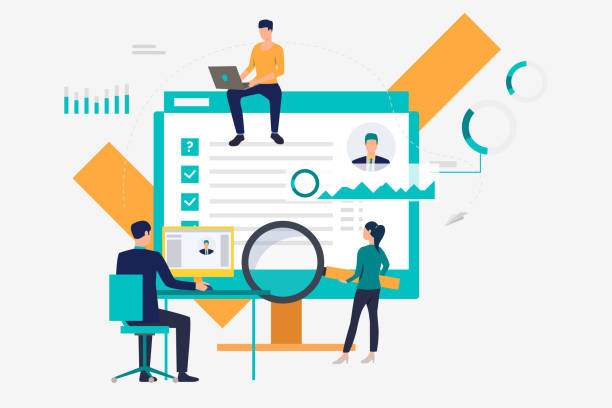What is Responsive Web Design and Why is it Crucial for the Future of the Web?

In the current digital age, where users access online content from a wide range of devices, from smartphones and tablets to laptops and large displays, the need for a unified approach to providing an optimal user experience is more pressing than ever.
This is where the concept of #Responsive_Web_Design# comes into play.
It is a web design approach that aims to create websites capable of automatically adapting their layout and content to the screen size and device the user is employing.
This adaptation includes adjusting the size of images, fonts, element arrangement, and even navigation menus to always provide the best visual and functional experience. Imagine a website that looks perfect on your desktop computer but becomes tiny and unreadable on a mobile phone; this is exactly the problem that responsive design solves.
The importance of this issue is not limited to aesthetics alone; rather, it directly impacts user experience, search engine rankings, and ultimately, the online success of a business.
In this explanatory chapter, we will explore the fundamental principles and the reasons for the importance of the responsive web design approach in today’s world.
This is an educational approach that will help you gain a deeper understanding of this key concept in web development and answers thought-provoking content regarding the future of web accessibility.
Are you dissatisfied with the low sales of your online store?
Rasaweb is your solution for having a professional and high-selling online store.
✅ Significant increase in sales and revenue
✅ Easy and enjoyable shopping experience for customers
⚡ Get a free consultation from Rasaweb right now!
Key Principles in Responsive Web Design: The Pillars of Web Stability

To successfully implement responsive web design, understanding three fundamental principles is essential: Fluid Grids, Flexible Images, and Media Queries.
Fluid grids mean that the website layout uses relative units like percentages for defining column widths and elements, instead of fixed pixels.
This approach ensures that the layout proportionally changes with the screen size, without requiring horizontal scrolling.
For instance, if a column occupies 20% of the page width, it will still take up 20% of that width on a smaller screen, thus ensuring content is displayed well at any size.
Flexible images complement fluid grids; they ensure that images do not exceed their containers and automatically adjust to the available space.
This is typically done using CSS `max-width: 100%`, which allows images to never exceed the width of their parent element.
Finally, media queries are the heart and soul of responsive web design.
This CSS3 capability allows developers to apply different styles based on device characteristics such as screen width, height, orientation (portrait or landscape), and even resolution.
For example, you can define that on small screens, the navigation menu transforms into a hamburger icon, while on large screens, it is displayed as a full navigation bar.
This combination of principles provides a specialized approach to building websites that intelligently respond to any device without needing separate versions, serving as a guide for developers to structure modern websites.
The Importance of the Mobile-First Approach in Responsive Design

The mobile-first concept in responsive web design is a paradigm shift where developers design primarily for the smallest screen (usually a mobile phone) and then progressively expand for larger devices.
This analytical approach is important because it helps designers focus on the core content and functionality of the website, avoiding unnecessary clutter that might disrupt the user experience on small devices.
When you design for mobile, you are forced to decide what is truly essential for the user, and this leads to a cleaner and more efficient user experience. This approach provides practical guidance for optimizing a website for mobile and, ultimately, for all devices.
Also, given that a significant portion of web traffic today comes from mobile devices, this is important news for any online business strategy.
Mobile-first design naturally leads to higher loading speeds and better performance, as unnecessary elements are removed from the outset, which directly positively impacts SEO and user experience.
This approach forms the foundation of responsive web design and ensures that your website not only looks good but also functions effectively on any device.
Below, you will find a comparison between mobile-first and desktop-first approaches in a table format:
| Feature | Mobile-First | Desktop-First |
|---|---|---|
| Design Starting Point | Smallest screen (mobile) | Largest screen (desktop) |
| Design Philosophy | Focus on core content and functionality | Adding features progressively for larger devices |
| Performance Optimization | Higher loading speed due to fewer extra elements | Loading speed may decrease due to extra elements |
| User Experience | Optimized and focused user experience on mobile, then desktop | Mobile experience might not be optimal due to scaling down |
| Importance for SEO | Approved by Google for mobile-first indexing | May face issues with Google’s mobile-first indexing |
Performance Optimization in Responsive Web Design: Speed, the Backbone of Success

One of the main yet crucial challenges in responsive web design is maintaining and improving website performance, especially loading speed, across all devices.
This specialized section shows you how to build a fast and efficient website using specific techniques.
Large and unoptimized images are one of the biggest obstacles to website loading speed. To overcome this, it is essential to use responsive images that load based on the user’s screen size (e.g., using the `srcset` attribute in HTML) and proper image compression.
Additionally, lazy loading for images and videos, meaning content is only loaded when the user scrolls to that part of the page, can significantly increase initial loading speed.
Optimizing CSS and JavaScript code by removing extra code and minifying them also plays a key role in reducing loading time.
In responsive web design, choosing appropriate web fonts and using a CDN (Content Delivery Network) to deliver content from the server closest to the user also helps improve performance.
These measures, in addition to increasing user satisfaction, directly impact your website’s ranking in search engines, as loading speed is an important factor in ranking algorithms.
This is a practical and explanatory guide to achieving the best web performance.
Does your company’s website create the professional and lasting first impression that potential customers should have of your business? If the answer is no, it’s time to have a professional and impactful corporate website with Rasaweb.
✅ Fully custom design tailored to your brand identity
✅ Increased lead generation and business credibility in the eyes of customers⚡ Contact us for a free consultation!
Flawless User Experience (UX) with Responsive Web Design

The ultimate goal of any website is to provide an excellent user experience (UX), and responsive web design is a powerful tool for achieving this goal across a wide range of devices. When a website is properly designed to be responsive, users do not need to zoom, scroll horizontally, or struggle to find information.
This means easier navigation, better content readability, and faster access to needed information, regardless of whether the user is on a small smartphone screen or a large monitor.
This directly affects the website’s Bounce Rate; the better the user experience, the more likely users are to stay on the site and interact with it.
Responsive design also helps maintain brand consistency, as the logo, color scheme, and overall website style remain consistent across all platforms.
This is an analytical approach to understanding user behavior and responding to their needs.
With responsive web design, you ensure that you send a clear and consistent message to your audience, without the need to maintain and update separate versions for mobile and desktop.
This is an educational approach that explains how to achieve maximum user satisfaction and, in a way, answers thought-provoking content about best design practices, ensuring every visitor, regardless of their device, feels comfortable and has easy access to content.
Responsive Web Design and Its Impact on SEO

In today’s digital world, SEO (Search Engine Optimization) is a vital element for online visibility, and responsive web design plays a significant role in improving your website’s ranking in search results. Google, as the largest search engine, has explicitly stated that it prefers responsive websites over non-responsive ones or those with separate mobile versions.
The reason is simple: a responsive website with a single URL allows Google to easily crawl and index all site content, without the need to crawl and index multiple versions, which can lead to duplicate content issues.
This is important news for anyone looking to improve their website’s visibility.
Additionally, high loading speed and optimized user experience, which are natural outcomes of responsive web design, are other important factors that Google considers in ranking websites.
Low bounce rates and higher visit durations, which result from good UX, also send positive signals to search engines.
In fact, by implementing responsive web design, you not only do a great service to your users but also simultaneously help search engines better understand your website and display it higher in rankings.
This is a practical and educational guide to achieving better SEO.
Popular Tools and Frameworks for Responsive Web Design

Implementing responsive web design no longer requires coding from scratch for every section.
Today, powerful tools and frameworks exist that significantly simplify the development process, allowing developers to quickly build responsive and efficient websites.
One of the most popular frameworks is Bootstrap, which provides a collection of HTML, CSS, and JavaScript tools for rapid development of responsive websites. Bootstrap, with its 12-column grid system, makes it easy to structure layouts for various devices.
Other frameworks like Foundation and Bulma are also excellent options, each with its own features and design philosophy.
In addition to CSS frameworks, platforms like WordPress, with responsive themes and plugins, have made building and managing responsive websites easy for non-technical users as well.
For visual design, tools like Figma, Sketch, and Adobe XD enable responsive design and prototyping, where designers can test their layouts in different dimensions before coding.
Using these tools accelerates the responsive web design development process and ensures that the final website is both beautiful and fully responsive.
This is a specialized section that provides practical guidance on choosing the right tools.
Below is a table of some popular responsive design frameworks and their key features:
| Framework | Key Features | Primary Use |
|---|---|---|
| Bootstrap | 12-column grid system, ready-to-use UI components, extensive support | Rapid development of websites and web applications |
| Foundation | High flexibility, advanced components, semantic design | Custom and complex projects, with a focus on UX |
| Bulma | CSS-only, Flexbox-based, modular and easy to use | Projects requiring a lightweight, CSS-only framework |
| Tailwind CSS | Utility-First framework, high design freedom | Projects requiring fully custom and unrestricted design |
Common Challenges and Solutions in Responsive Web Design

Despite numerous advantages, implementing responsive web design can also come with challenges.
Understanding these challenges and having appropriate solutions helps developers successfully complete their projects.
One of the most common issues is managing complex and voluminous content on small screen sizes. The solution to this problem is to use techniques such as Progressive Disclosure, where only essential information is initially displayed, and more details are revealed with user interaction.
Also, neglecting the importance of performance and optimizing images and scripts can lead to slow website speeds on mobile devices.
The solution to this, as previously mentioned, is meticulous resource optimization.
Another challenge is ensuring cross-browser compatibility and responsiveness across diverse devices, which requires thorough and continuous testing.
Using responsive testing tools and various browsers to test the website at different stages of development is essential.
Finally, maintaining aesthetics and user experience across all sizes without losing brand visual identity can be challenging.
This requires a thoughtful and creative design approach where designers, with a deep understanding of responsive web design principles, provide innovative solutions.
This explanatory and analytical section offers guidance for overcoming obstacles and delivering a high-quality final product.
Does your current website build the trust that potential customers should have in your business? If the answer is no, it’s time to have your professional and impactful corporate website with Rasaweb.
✅ Fully custom design tailored to your brand identity
✅ Increased lead generation and business credibility in the eyes of customers⚡ Contact us for a free consultation!
The Future of Responsive Web Design: Beyond Mobile and Desktop

The world of technology is evolving at an incredible pace, and the future of responsive web design extends beyond traditional mobile and desktop devices.
The emergence of new devices such as smartwatches, smart TVs, wearable gadgets, and even internet-connected cars creates new challenges and opportunities for web designers.
In the future, websites must be able to respond not only to screen dimensions but also to the user’s interaction environment (voice, touch, movement) and even personal preferences. This is a news and entertaining content piece that explores future possibilities.
Concepts like Web Components and modular design allow developers to build websites that easily adapt to the needs of new and unknown devices.
Also, with advancements in artificial intelligence and machine learning, we can expect websites to intelligently personalize their content and user interface based on each user’s behavior and preferences.
This means a fully customized and dynamic experience that goes beyond simply resizing elements.
Responsive web design in the future will mean adaptability to any type of interaction and platform, turning the web into a truly global and pervasive experience.
This analytical approach helps us prepare for what will happen in the near future.
Conclusion: Responsive Web Design, a Big Step Towards Ubiquitous Web

In conclusion, it is clear that responsive web design is no longer a luxury option, but an absolute necessity for any modern and successful website. This approach lays the foundation for a ubiquitous web, where online content and services are accessible without any limitations on any device and for any user.
From improving user experience and increasing customer satisfaction to enhancing search engine rankings and reducing maintenance costs, the benefits of responsive web design are undeniable.
As explored in previous chapters in an explanatory, educational, specialized, and analytical manner, key principles, the mobile-first approach, performance optimization, and the use of appropriate tools all help you build websites that are not only beautiful but also function effectively in today’s multi-device world.
This is a guide to building the future of the web.
By investing in responsive web design, you are effectively investing in the sustainability, accessibility, and long-term success of your online presence.
Given the rapid changes in web technologies and the continuous emergence of new devices, responsive web design ensures that your website is ready for future challenges and can successfully endure in this competitive space.
Therefore, for businesses and developers, choosing the responsive web design method is a smart and strategic choice for a brighter future in the online space.
Frequently Asked Questions
| Question | Answer |
|---|---|
| What is Responsive Web Design? | It is a method for designing websites that optimizes the appearance and functionality of the website based on the screen size of the user’s device (mobile, tablet, laptop, etc.). |
| Why is responsive design important? | Due to the increased use of various devices for internet access, responsive design provides a better user experience, improves website SEO, and reduces maintenance costs. |
| What are the most important responsive design tools? | Media Queries in CSS, use of relative units (such as percentages, em, rem, vw, vh), Flexible Images, and Grid Systems. |
| What role do Media Queries play in responsive design? | Media Queries allow the application of different CSS styles based on device characteristics (such as screen width, height, orientation, and screen type). |
| What is the Mobile-First concept in responsive design? | It is an approach where design and development begin first for the smallest screen (mobile) and then progressively expand for larger screens (tablet, desktop). |
| Does responsive design affect website SEO? | Yes, Google prefers responsive websites because they offer a better user experience and eliminate the need for separate mobile and desktop versions, which helps improve SEO rankings. |
| What does Fluid Layout mean? | It means that the width of page elements, instead of fixed pixel values, is defined using relative units (such as percentages) to automatically adjust with screen size changes. |
| How are Flexible Images used in responsive design? | By setting the `max-width: 100%;` property for images in CSS, it is ensured that the image never becomes larger than its container, and its scale is maintained when the screen size changes. |
| What are the differences between responsive design and adaptive design? | Responsive design uses a single layout that fluidly adapts to any screen size, while adaptive design uses several fixed, predefined layouts for specific screen sizes. |
| Are CSS frameworks like Bootstrap useful in responsive design? | Yes, frameworks like Bootstrap have a responsive Grid System and pre-designed components that significantly simplify and speed up the process of building responsive websites. |
And other services of Rasa Web advertising agency in the field of advertising
Using local advertising in ads for pet supply manufacturers
Investigating the impact of seasonal ads on pet supply sales
Increasing credibility by presenting portfolios in manufacturer ads
The role of multilingual ads in attracting international customers
Examining methods to increase sales through special ads for manufacturers
And hundreds of other services in the field of online advertising, advertising consulting, and organizational solutions
Online Advertising | Advertising Strategy | Advertorial
🚀 Build your online business future today with Rasaweb Afarin, a leading digital marketing agency. We pave your path to success by offering creative and specialized solutions, including multilingual website design, SEO, and targeted social media management. Trust us to shine in the digital world.
📍 Tehran, Mirdamad Street, next to Bank Markazi, Kazerun Jonoubi Alley, Ramin Alley, No. 6

